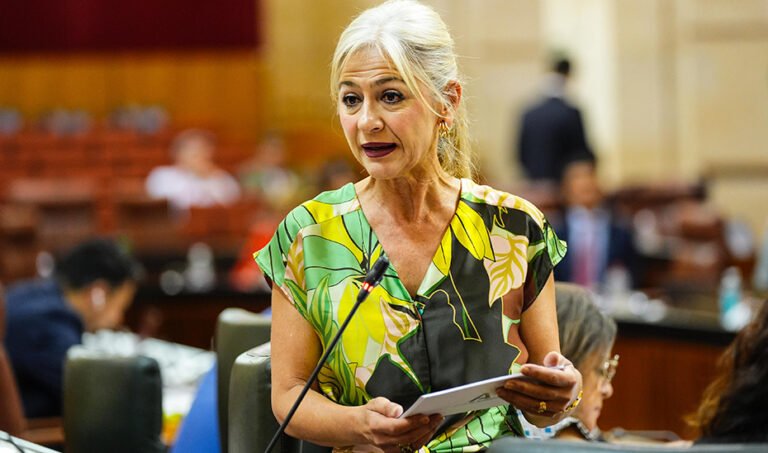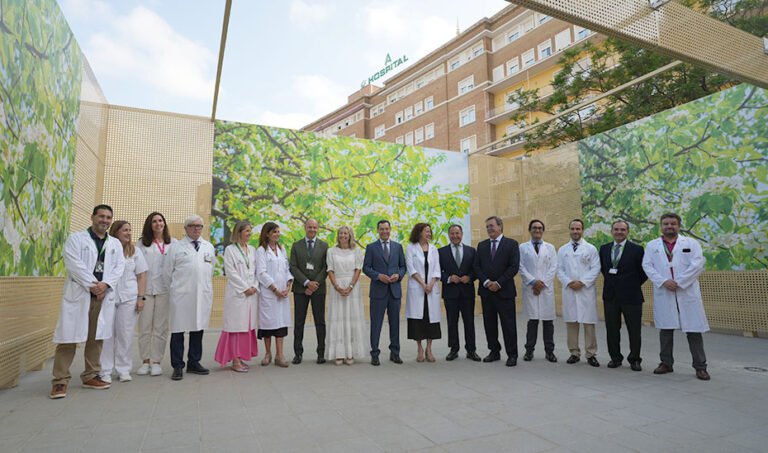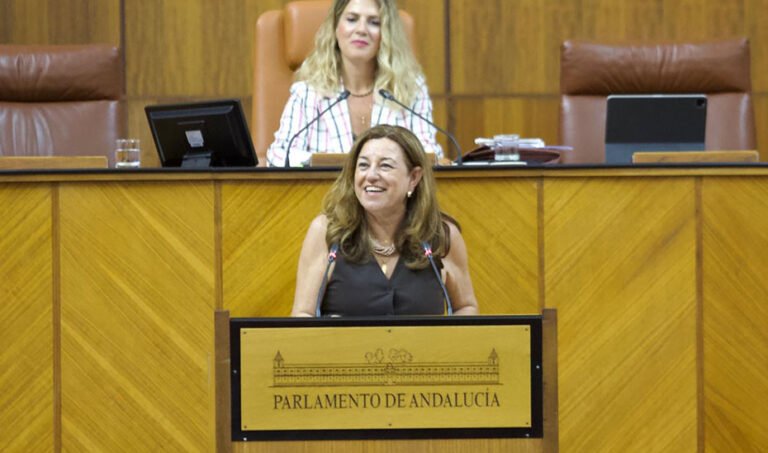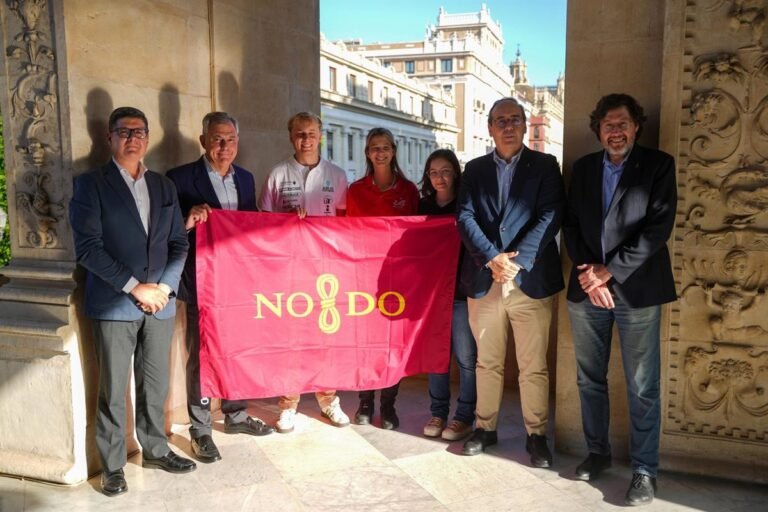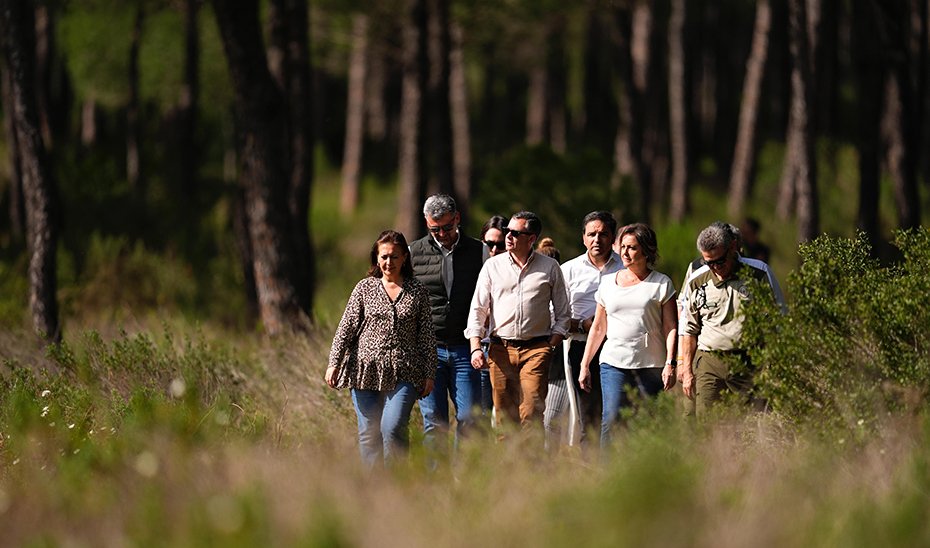
The Minister for Sustainability and Environment, Catalina García, has visited the Doñana Natural Space, in the municipality of Hinojos (Huelva), to verify on-site the positive effects of the accumulated rainfall in recent months and convey the commitment of the Andalusian Government to the active conservation of this unique enclave. During her tour of the marshland, the Minister has appreciated the ecosystem’s response to a «historic» hydrological situation, while highlighting the value of extensive livestock farming and the actions promoted by the Andalusian Government to preserve biodiversity and enhance the park’s resilience to climate change.
As explained by Catalina García, the rainfall recorded in recent months has reached historical levels, leading to the reactivation of the hydraulic system that feeds the marshes. She specified that in some stations, more than 700 liters per square meter have been recorded. «This situation has allowed March to be classified as one of the rainiest months on record, with over 250 liters per square meter just in March,» she added.
This circumstance has resulted in widespread flooding, to the extent that there are already over 28,000 hectares flooded out of the 30,000 that the National Park comprises, and at least 11,000 out of the total 20,000 hectares of the Natural Park, a number that could be even higher if partially flooded agricultural areas were included.
«This widespread flooding is referred to here as a ‘swell’, and it represents a natural phenomenon that covers almost the entire topography of the marshland. It is something we haven’t seen since 2010 and has created a continuous water landscape where it is difficult to distinguish between low marshland, high marshland, veins, and pools,» she stated. The Minister emphasized that while this phenomenon may cause occasional difficulties for fauna or livestock, it is extraordinarily beneficial for the hydrological balance of the area, as it anticipates a particularly favorable spring for the reproduction of waterfowl and the development of native vegetation. She also noted that a significant improvement in aquifer recharge is expected, which is «hopeful news after more than a decade of very concerning records.»
The key role of extensive livestock farming
This flood has had a direct impact on the livestock farming activity carried out within the National Park. During the visit, the Minister explained that farmers have been forced to move cattle, sheep, and horses grazing in the marshland to other designated farms for animal welfare reasons. «The water level has transformed many areas where animals usually graze into temporary ponds, necessitating a rapid and coordinated response to protect the animals and ensure their safety,» she pointed out.
This episode has underscored, in Catalina García’s words, the importance of continuing to promote extensive livestock farming as an ally of the environment. «The Andalusian Government has strongly supported this traditional practice, which not only preserves our native breeds and landscapes but also helps prevent fires, promotes sustainable land management, and strengthens rural communities,» she stated. In this regard, she emphasized that the Andalusian Government has promoted the Pasture-Firebreak Areas Network (RAPCA), through which over 100,000 heads of cattle actively collaborate in reducing forest fuel, thus reducing the risk of fires while generating employment and economy in rural areas.
The Minister highlighted that extensive grazing is a key tool in bioeconomics, the fight against climate change, and rural sustainability, and she recalled that the new Andalusian regulatory framework currently in progress, the Forest Law, for the first time recognizes grazing as a strategic use of the land. She also indicated that specific investments are being made in infrastructure improvements, such as watering holes, clearing for expanding grazing areas, or forest tracks, as well as a dozen measures within the Andalusian Forest Plan 2030 to promote silvopastoral uses, such as habitat improvement, incentives for native breeds, and streamlining procedures for public pastures. «We want extensive livestock farming to be profitable, recognized, and fully compatible with conservation. It is undoubtedly synonymous with the future of Andalusia,» she added.
During her visit to Hinojos, Catalina García was accompanied by the mayor of the town, Joaquina del Valle Ortega; the Government Delegate of the Junta in Huelva, José Manuel Correa; the Director General of Protected Natural Spaces, José Enrique Borrallo; the Director of the National and Natural Park of Doñana, Juan Pedro Castellano; the President of the Participation Council of the Natural Space, Enrique Mateos; and the Territorial Delegate for Sustainability and Environment, Pedro Yórquez, among other authorities.
Actions of the Junta in Doñana
During the visit, the Minister for Sustainability and Environment took the opportunity to review the actions being carried out in Doñana to strengthen its protection and restore its ecosystems. Thus, she particularly emphasized the acquisition of the ‘Veta la Palma’ and ‘Tierras Bajas’ estates, which have resulted in the addition of 8,700 hectares to the Andalusian public domain, with an investment of around 80 million euros. «This is undoubtedly a fundamental step to ensure a more integrated and coherent management of the park’s natural resources,» she stressed.
The Minister explained that since January 2024, intensive work has been done with the technical team of ‘Veta la Palma’ to adapt the hydraulic management model to the new conservation and biodiversity goals. «This first year of transition has allowed us to make key adjustments in hydraulic management and carry out interventions for ecosystem improvement,» stated Catalina García, noting that in December, the process for hiring hydraulic management support services was completed, with an annual investment of 792,000 euros, which began in February.
In addition to these acquisitions, she recalled that over 6 million euros are being invested in actions co-financed with European funds from the Recovery, Transformation, and Resilience Plan. These include habitat restoration, temporary pond recovery, elimination of invasive exotic species, and ecosystem adaptation to the effects of climate change. She also referred to the improvement works on the channels and micro-drainage network of the park, essential to ensure adequate and stable water flow.
The Minister also valued the improvements made in the visitor centers of the National Park, such as La Rocina, El Acebrón, José Antonio Valverde, and the Ice Factory. «These spaces not only serve an educational function, bringing the value of Doñana to thousands of people, but also act as drivers of ecotourism and sustainable rural development,» she stated. In this vein, she explained that work has been done to adapt the gate system to improve the park’s connection with the Torre Arm and the Guadalquivir River, which represents a significant enhancement in the hydraulic management of the enclave.
Finally, she highlighted the ongoing work in the area affected by the Las Peñuelas fire in 2017, where over 10,000 hectares were lost. «The restoration plan has been recognized as a good practice example at the national and European levels. With it, we have not only reclaimed land but also strengthened the park’s ability to face new climate challenges,» Catalina García concluded.

